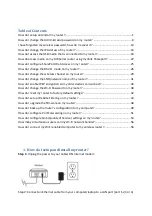
5G OUTDOOR CPE FW2010 USER GUIDE
53
•
Kbps
— Kilobits per second. The rate of data flow.
•
LAN
— Local Area Network. A type of network that lets a group of computers, all in close
proximity (such as inside an office building), communicate with one another. It does not use
common carrier circuits though it can have gateways or bridges to other public or private
networks.
•
M2M
— Machine to machine. Direct communication between devices. This may include wired
or wireless communication.
•
MAC Address
— Media Access Control. A number that uniquely identifies each network
hardware device. MAC addresses are 12-digit hexadecimal numbers. This is also known as the
physical or hardware address.
•
Mbps
— Megabits per second. The rate of data flow.
•
MNO
— Mobile Network Operator. The vendor that provides your wireless access. Known by
different names in different regions, some examples are: wireless provider, network provider, or
cellular carrier.
•
MSID
— Mobile Station IDentifier. A number for a mobile phone that identifies that phone to
the network.
•
Network Operator
— The vendor that provides your wireless access. Known by different names
in different regions, some examples are: wireless provider, network provider, or cellular carrier.
•
Network Technology
— The technology on which a particular network provider’s system is
built; such as LTE or GSM.
•
NMEA port
— National Marine Electronics Association port. The port through which
applications can access a GPS data stream.
•
NNTP
— Network News Transfer Protocol. The primary protocol used to connect to Usenet
servers and transfer news articles between systems over the Internet.
•
PAP
— Password Authentication Protocol. A protocol used by Point to Point Protocol (PPP) to
validate users. PAP does not encrypt data and sends the password and username to the
authentication server as plain text. Most network operating system remote servers support PAP.
•
PCI
— Physical Cell ID. Each PCI corresponds to one 5G NR cell or LTE cell and consists of two
parts: PSS Primary Synchronization Signal (PSS) and Secondary Synchronization Signal (SSS).
•
POP3
— Post Office Protocol 3. A protocol in which email is received and held for you by your
Internet server until you download it.
•
Port
— A virtual data connection used by programs to exchange data. It is the endpoint in a
logical connection. The port is specified by the port number.
•
Port Forwarding
— A process that allows remote devices to connect to a specific computer
within a private LAN.
Содержание Wavemaker FW2010
Страница 1: ...Inseego WavemakerTM 5G Outdoor CPE FW2010 USER GUIDE...
Страница 4: ...5G OUTDOOR CPE FW2010 USER GUIDE 4 1 Introduction and Getting Started Overview Getting Started...
Страница 46: ...5G OUTDOOR CPE FW2010 USER GUIDE 46...
Страница 50: ...5G OUTDOOR CPE FW2010 USER GUIDE 50 5 Glossary...



































